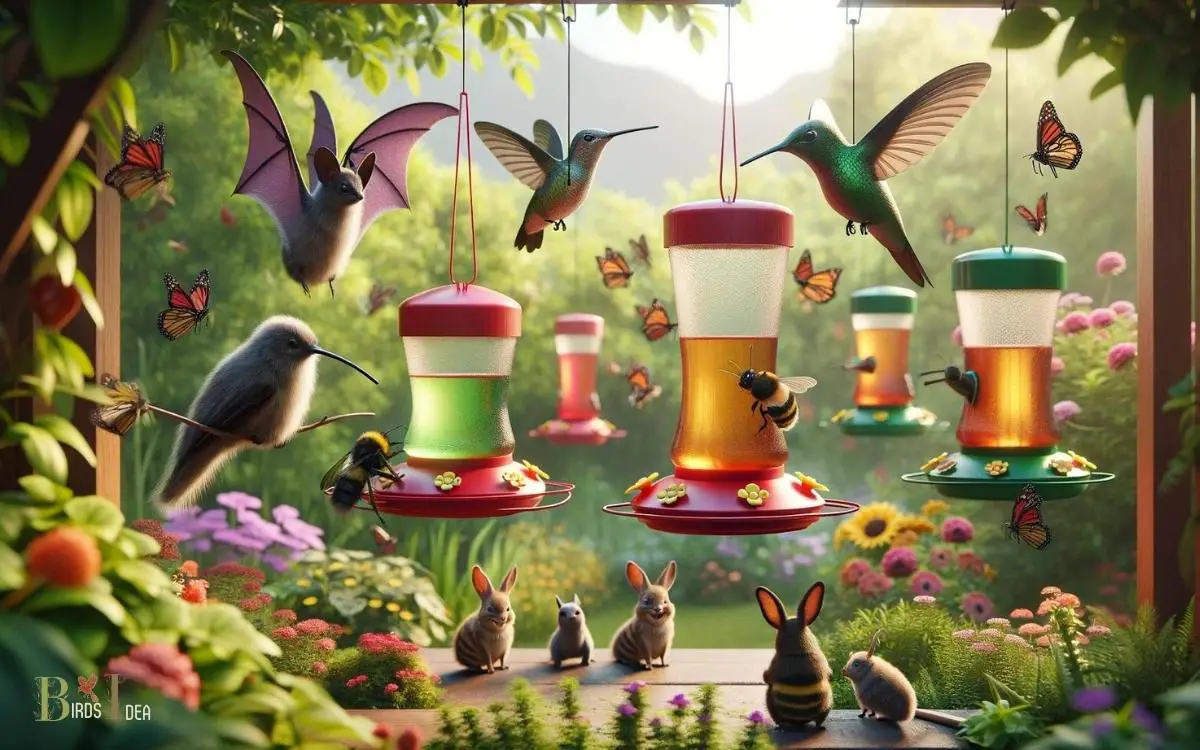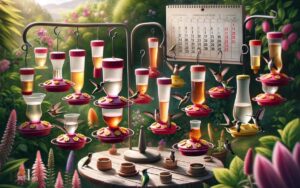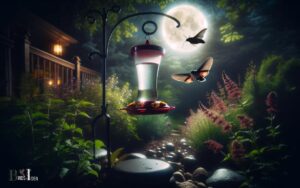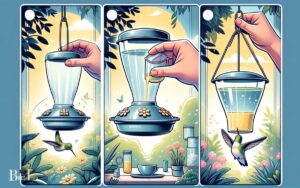Do Bats Eat Hummingbird Food? Yes!
Yes, some species of bats do consume hummingbird food, specifically nectar. They are known to visit hummingbird feeders at night to drink the sugar-water solution intended for hummingbirds.
Bats have varied diets, but nectarivorous bats, like the lesser long-nosed bat and the Mexican long-tongued bat, feed on nectar and are known to visit hummingbird feeders.
These species have long tongues adapted for reaching into flowers, which also makes them capable of accessing feeder ports. Not all bats eat from hummingbird feeders, as many are insectivorous or frugivorous.
- Lesser long-nosed bat: Nectar and pollen consumer, known to visit feeders.
- Mexican long-tongued bat: Consumes nectar, pollen, and fruits, may visit feeders.
Bat visits to hummingbird feeders highlight the adaptability of wildlife in urban environments.

Key Takeaway
Bat Dietary Habits
Bats primarily feed at night to forage for insects, fruits, nectar, and sometimes small vertebrates.
Their dietary habits play a crucial role in maintaining ecological balance and controlling insect populations, making them valuable contributors to ecosystems.
By consuming insects, bats help to minimize the spread of diseases and reduce agricultural pests, benefiting both humans and the environment.
Some bat species are essential pollinators for various plants, including those that produce fruits and nectar.
Understanding the dietary habits of bats is essential for conservation efforts and ensuring the sustainability of ecosystems.
By providing suitable habitats and preserving their food sources, we can support the well-being of bats and the vital roles they play in serving the environment and the communities that depend on it.
Hummingbird Food Composition
Hummingbird food consists of a mixture of water and sugar, typically in a ratio of four parts water to one part sugar, providing the necessary energy for their high metabolism and rapid wing beats.
The sugar used is typically white, granulated cane sugar, as it most closely mimics the nectar found in flowers, which is the primary food source for hummingbirds.
It is important to use only white sugar, as other sweeteners can be harmful to hummingbirds. Red food coloring is often added to the sugar water to attract hummingbirds, although it is not necessary and some studies suggest it may be harmful.
Some commercial hummingbird food also contains added vitamins and minerals to supplement the birds’ diet and aid their overall health.
Bats’ Attraction to Sweet Nectar
The nutritional allure of sweet nectar to bats is a key factor in understanding their attraction to this natural food source. Bats are drawn to the high-energy content of nectar, which serves as a vital fuel source for their high metabolic demands.
The sweet aroma and high sugar content of nectar act as powerful attractants for bats, guiding them to flowering plants, where they play a crucial role in pollination.
Understanding the attraction of bats to sweet nectar is essential for those seeking to support bat populations and preserve the important ecological services they provide.
By cultivating nectar-rich plants and creating bat-friendly habitats, individuals can contribute to the well-being of bats and the ecosystems they inhabit, ultimately serving the broader goal of biodiversity conservation.
Impact of Hummingbird Feeders
Feeding hummingbirds can lead to increased competition for resources among the local avian population. While the presence of hummingbird feeders can bring joy to bird enthusiasts, it’s important to consider their potential impact on other birds in the area.
Here’s a table summarizing the potential impacts of hummingbird feeders:
| Impact | Description |
|---|---|
| Competition for nectar | Other nectar-feeding birds may struggle to access natural nectar sources. |
| Disease transmission | Feeders can facilitate the spread of diseases among birds. |
| Predation risk | Feeders may concentrate birds in one area, making them more vulnerable to predators. |
| Displacement of species | Aggressive hummingbirds may drive other birds away from the area. |
| Habitat alteration | Overcrowding around feeders can lead to changes in natural bird behavior. |
Considering these potential impacts, it’s important to thoughtfully manage hummingbird feeders to minimize negative effects on the local avian population.
Observations in Bat Behavior
Observing bat behavior provides valuable insights into their feeding patterns, which in turn have significant impacts on ecosystems.
Understanding the interactions between bats and their environment is essential for preserving biodiversity and maintaining ecological balance.
Studying human-bat interactions can help mitigate potential conflicts and ensure the conservation of both bat populations and the resources they rely on.
Bat Feeding Patterns
While studying bat feeding patterns, researchers have observed distinct behaviors that shed light on their foraging habits and dietary preferences.
Bats exhibit diverse feeding patterns, with some species being insectivorous, frugivorous, nectarivorous, or sanguivorous.
Their foraging behaviors vary based on their dietary preferences and the availability of food sources in their habitats.
Observations have revealed that insectivorous bats use echolocation to locate and capture flying insects, while frugivorous bats primarily feed on fruits and nectar from flowers. Nectarivorous bats play a crucial role in pollination as they visit flowers to feed on nectar.
The following table summarizes the diverse feeding patterns observed in different bat species:
| Feeding Pattern | Dietary Preferences |
|---|---|
| Insectivorous | Insects |
| Frugivorous | Fruits |
| Nectarivorous | Nectar, Pollen |
| Sanguivorous | Blood |
Impact on Ecosystems
The diverse feeding patterns observed in different bat species have a significant impact on ecosystems, influencing pollination, insect control, and fruit dispersion.
Bats play a crucial role in maintaining the balance of natural ecosystems through their foraging behaviors.
Their impact on ecosystems can be observed in the following ways:
- Pollination: Bats aid in the pollination of various plants, including agave, banana, and mango, contributing to the reproduction of essential flora.
- Insect control: Bats serve as natural pest controllers, consuming a vast number of insects, thus helping to regulate insect populations.
- Fruit dispersion: By consuming fruits and dispersing seeds across different locations, bats contribute to the propagation and diversity of plant species.
- Ecosystem health: The presence of bats in ecosystems supports overall environmental health and stability.
Human-Bat Interactions
Human-bat interactions play a pivotal role in understanding the behavioral patterns that contribute to the impact of bat species on ecosystems.
Observing bat behavior in the presence of humans provides valuable insights into their foraging habits, roosting preferences, and overall response to human activities.
These interactions also shed light on the potential risks and benefits associated with human-bat encounters.
By closely studying how bats behave in the presence of human activities, researchers and conservationists can develop strategies to minimize negative impacts on bat populations while promoting coexistence.
Understanding human-bat interactions is essential for implementing effective conservation measures and ensuring the well-being of both bats and humans.
This knowledge also aids in addressing public concerns and fostering a greater appreciation for the vital role that bats play in maintaining ecological balance.
Understanding these risks is crucial for implementing measures to ensure the safety and well-being of hummingbirds in areas where bats are present. Now, let’s explore strategies for coexistence and solutions to mitigate these risks.
Do Bats and Squirrels Have Similar Food Preferences?
Bats and squirrels display distinct food preferences. While bats primarily consume insects, fruits, and nectar, squirrels have a broader diet that extends to nuts, seeds, berries, and fungi. While squirrels might occasionally sample nectar, it is not a significant part of their diet. Therefore, “squirrels and hummingbird food” would mainly pertain to the specific dietary needs of hummingbirds rather than squirrels.
Coexistence and Solutions
Coexistence and solutions for managing the potential risks to hummingbirds stemming from bat activity include implementing protective measures and habitat management strategies.
Protecting hummingbird feeders from bats can be achieved by using specialized feeders with bee guards or implementing physical barriers such as wire cages.
Managing the surrounding habitat to deter bats, such as trimming trees and vegetation around feeders, can help reduce the risk of bat interference.
When considering the coexistence of bats and hummingbirds, it’s crucial to prioritize the well-being of both species.
By employing these protective measures and habitat management strategies, it is possible to create a harmonious environment where both bats and hummingbirds can thrive.
| Protective Measures | Habitat Management |
|---|---|
| Specialized feeders with bee guards | Trim trees and vegetation around feeders |
| Wire cages around feeders | Maintain well-lit areas to deter bats |
Conclusion
The consumption of hummingbird food by bats poses potential risks to the well-being of the hummingbirds.
It is important for individuals to consider the impact of their actions on the coexistence of different species.
By being mindful of the potential consequences of attracting bats to hummingbird feeders, we can work towards finding solutions that promote the harmonious cohabitation of these creatures in their natural environment.






